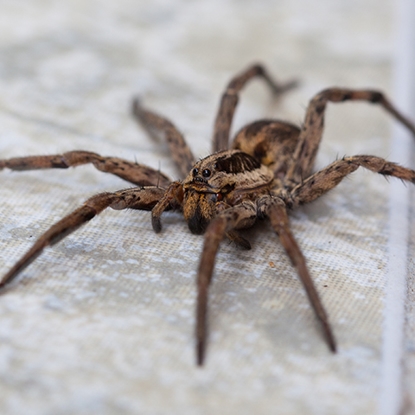
Spiders

About
What are spiders?
Spiders are arachnids, and are closely related to mites, ticks, and scorpions. They are beneficial predators that feed on many nuisance insects and other arthropods, helping to keep their populations in check.
All spiders have two body regions - the cephalothorax and abdomen. They have eight legs, no wings or antennae, and chelicerae (fangs). Spiders usually have eight eyes. Web-building spiders typically have poor eyesight. They rely on vibrations and their webs to catch their prey. Hunting spiders have excellent eyesight that they use to hunt and capture their prey.
Spiders come in a wide range of colors and sizes depending on their exact species. Some species of spiders are hairy, while others are smooth and shiny. Spiders are arthropods and have exoskeletons, meaning their skeletons are located on the outside of their bodies.
Are spiders dangerous?
Most household-invading spiders living throughout Texas are harmless and pose no threat to people. However, brown recluse spiders and black widow spiders both live in Texas. They are considered to be dangerous and medically significant. A bite from either species of spider should be taken seriously. The severity of symptoms depends on the location of the bite and how much venom is injected. If bitten by a dangerous spider, medical attention should be sought so your symptoms can be treated.
Why do I have a spider problem?
Spiders can live in large populations and may become a problem on any property that offers ample food and shelter sources. Spiders prefer to live outside in dark, sheltered spaces. Spiders are reclusive by nature and do their best to stay out of sight of people and predators.
Spiders can become a problem inside homes after accidentally finding their way inside while foraging for food. They also will move indoors when the weather outside becomes too cold, wet, hot, or dry. They also often follow as their prey moves indoors to seek safe shelter.
Where will I find spiders?
Spiders living outside create their webs or burrows in garden areas, shrubs, bushes, overgrown vegetation, tall grasses, between rocks and stones, underneath decks and porches, and in wood piles.
Spiders that have found their way inside nest in quiet spots such as in the corners of closets, in basements, in boxes, in clothing and shoes, under bedding, in potted plants, under furniture, in attics, behind wall voids, and underneath sinks.
How do I get rid of spiders?
The easiest and fastest way to control spider populations is with the assistance of a trained professional. At Pest-Pro Services, Inc., the first step we take to get rid of spiders is to provide a free inspection and estimate. Our dedicated technicians then provide the year-round pest control services and maintenance visits needed to rid your home and property of spiders.
Pest-Pro Services, Inc. is committed to using advanced products to eliminate spiders and prevent their return through our guaranteed pest control services. To learn more about eliminating spiders from your Gilmer, Longview, or Texarkana-area home, contact Pest-Pro Services, Inc.
How can I prevent spider infestations?
In combination with professional pest control services from Pest-Pro Services, Inc., there are things that you can do around your Texas home and property to make it less attractive to invasive and potentially dangerous spiders:
- Remove piles of wood, fallen trees, rock piles, and other piles of debris from your property.
- Keep your lawn cut short and maintained.
- Cut back tree branches and bushes that touch the outside of your home.
- Seal gaps or cracks in the foundation and exterior walls of your home.
- Make sure that weather stripping is placed around exterior windows and doors.
- Replace any torn window or door screens.
- Get rid of water sources by making sure gutters are clear and repairing any leaky pipes, faucets, or fixtures.
- Reduce food sources (insects) by putting into place a year-round professional pest control program.